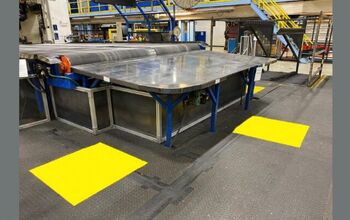UAW Broadens Strike to Target Stellantis Truck Plant

On Monday, United Auto Workers (UAW) members went on strike at Stellantis's biggest assembly plant. The move is part of the union’s plan to gradually ramp up pressure against all three of the American-based automakers the UAW is presently in contract negotiations with.
We’ve recently seen the union targeting increasingly important facilities after talks appear to have stagnated. Less progress seems to have been made in recent weeks, with unions ramping up pressure and corporations hoping to sway public opinion via the media.
Action began on September 15th with the union announcing a “stand-up strike” that would see members called to walk out of targeted factories with very little notice. Automakers responded by laying off employees the following week, citing complications from work stoppages that were impacting supply lines.
Things have ramped up since then, with an estimated 40,000 union members working at Ford, General Motors, and Stellantis striking as additional plants were targeted. This represents over 25 percent of their entire workforce.
The latest action taken by the UAW pulled out 6,800 workers at the Michigan plant (owned by Stellantis) that’s responsible for the highly profitable RAM 1500 pickup. Union leadership said the facility had been targeted due to Stellantis having offered the “worst proposal” in regard to wage increases, cost-of-living adjustments, and the timeline required for employees to reach full-time status.
Hitting Stellantis’ Sterling Heights truck plant is highly reminiscent of the recent walkout seen at Ford's Kentucky Truck assembly plant. These are the vehicles that matter most to those brands and shutting them down is a fairly serious escalation.
UAW President Shawn Fain has intentionally taken a more combative stance than his predecessors in an effort to restore workers' benefits lost during the mid-2000s as part of the concessions designed to keep manufacturers from going bankrupt. However, both General Motors and Chrysler (now Stellantis) ended up taking government bailouts anyway.
Fain is likewise hoping to prove he’s not a pawn of the industry after a years-long court case proved a portion of the UAW’s former leadership was involved in a bribery scandal. He’s been emphatic that he’s not interested in cooperating with automakers or politicians if the end result doesn’t benefit American workers he claims have been taken advantage of for decades. While this originally seemed to endear him to the corporate media, he’s gotten less favorable coverage since telling politicians this isn’t their show to run.
A case in point is a recent article from the Associated Press suggesting that Fain’s demands may be out of whack with reality. The piece calls him “confrontational” while quoting anonymous automotive executives claiming they’re not sure whether the UAW actually has an end-game strategy. There’s also been a rash of speeches given by industry CEOs hinting that the UAW might push so hard that it jeopardizes the future of automotive employees.
That may end up being true. There’s certainly a limit to what the industry can endure in terms of the strike (which is the whole point of collective bargaining) and concessions will have to be made by at least one side if this battle is ever going to end. But this perspective seems to ignore how much money the industry has dumped into all-electric vehicles, autonomous driving systems, and other costly avenues that don’t appear to have yielded much in the way of profitability. It also sidesteps the broadening wage gap between staff and management during a period when companies were enjoying record-setting profits.
The UAW’s demands were chosen specifically to prove a point about how much executive compensation (and bonus pay) has exploded in recent decades as the wages of their core labor force haven’t even kept pace with inflation and benefits were walked back. We’ve covered this before. But it’s an important component in explaining why the UAW is taking such a hard stance against the industry right now.
The union has demanded a 40 percent wage hike over several years (including an immediate 20 percent increase), improved (or restored) employee benefits, and assurances that workers manufacturing EV batteries will likewise be covered under union agreements.
While automotive executives are publicly predicting economic doom if the union doesn’t relent, Fain has asked UAW members not to cave to the mounting pressure. He said that the corporate playbook is to stoke "fear, uncertainty, doubt and division" during contract negotiations — recommending that union members ignore those efforts. But he’s also suggested that talks may be nearing an end and a formal agreement could be reached soon.
[Image: UAW]
Become a TTAC insider. Get the latest news, features, TTAC takes, and everything else that gets to the truth about cars first by subscribing to our newsletter.

A staunch consumer advocate tracking industry trends and regulation. Before joining TTAC, Matt spent a decade working for marketing and research firms based in NYC. Clients included several of the world’s largest automakers, global tire brands, and aftermarket part suppliers. Dissatisfied with the corporate world and resentful of having to wear suits everyday, he pivoted to writing about cars. Since then, that man has become an ardent supporter of the right-to-repair movement, been interviewed on the auto industry by national radio broadcasts, driven more rental cars than anyone ever should, participated in amateur rallying events, and received the requisite minimum training as sanctioned by the SCCA. Handy with a wrench, Matt grew up surrounded by Detroit auto workers and managed to get a pizza delivery job before he was legally eligible. He later found himself driving box trucks through Manhattan, guaranteeing future sympathy for actual truckers. He continues to conduct research pertaining to the automotive sector as an independent contractor and has since moved back to his native Michigan, closer to where the cars are born. A contrarian, Matt claims to prefer understeer — stating that front and all-wheel drive vehicles cater best to his driving style.
More by Matt Posky
Latest Car Reviews
Read moreLatest Product Reviews
Read moreRecent Comments
- Sayahh While some ppl like Camry/Accord as ppl movers, ppl who can afford it might choose ES/TLX or even Mercedes and BMW sedans over any domestic offerings. Unsure what will happen to police departments when Chargers stop being offered (as an ICE sedan). With Taurus and the SS gone, will they just all go with Explorers, Interceptors, Blazers,Durangos and Tahoes?
- 28-Cars-Later The platform is likely at the end of it's life cycle and GM decided probably two or three years ago to not put the R&D in to replace it. Now should GM emulate LX and Panther and just crank these out until there are literally no buyers? Yes unless they are somehow unprofitable, but unlike Panther and LX who had near monopolies in the type of vehicles they were Malibu competes with the Asian marques so someone decided in 2021ish to pull the plug.
- Duties GM killing the Malibu actually makes sense; it is a poor also-ran in the category. What doesn’t make sense are all carmakers trying to jam EVs down our throats, not because consumers demand them, but because a two bit, would be dictator says to.
- FreedMike I agree totally that it is a mistake to kill the Malibu, but I'll say this for GM: of the D3, they're doing the best job of providing affordable crossovers that don't suck. I hear nothing but good things about the new Trax.
- SilverCoupe The item on the back of the front seats with the wood and chrome surround appears to be an ashtray to me, though I do not know that to be true.

































Comments
Join the conversation
I just read General Custer has decided to lay siege to GM's Arlington plant due to it's recent overall corporate success, time for a new post?
BONUS: In the same ZH piece I happened across this post and am wondering if he hit the nail on the head:
Anyone else wondering if this isn't a stealth "mothballing" of the domestic auto industry factories in prep for what's coming next year?
Shawn Fain steps up to the plate……the OEM makes its offer……a-n-n-n-d……Whammy! Ha-Whamm-Eee!